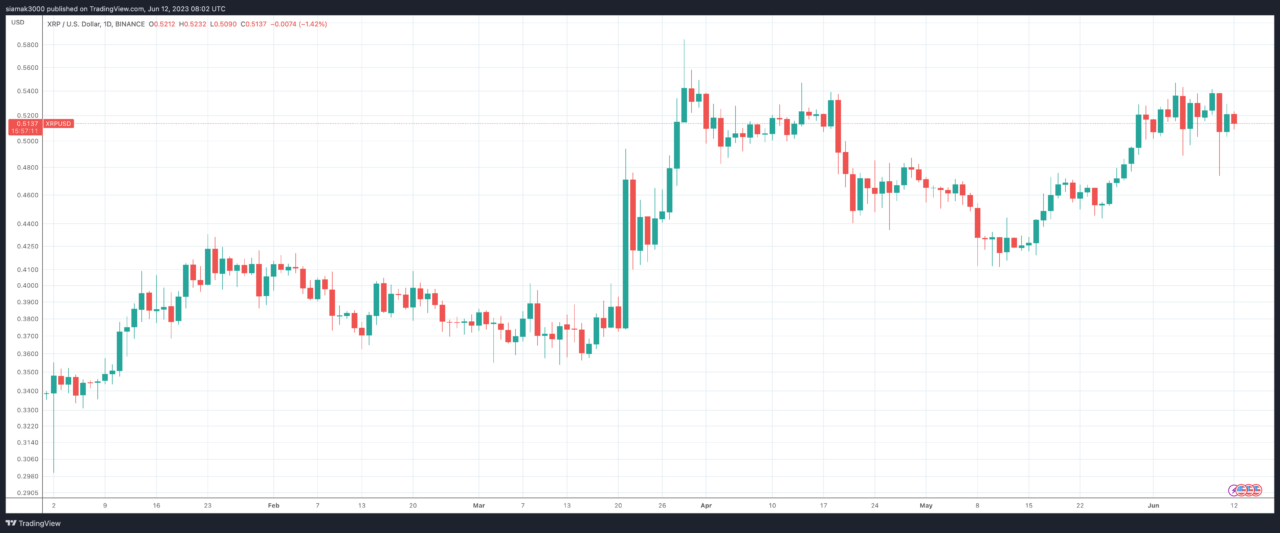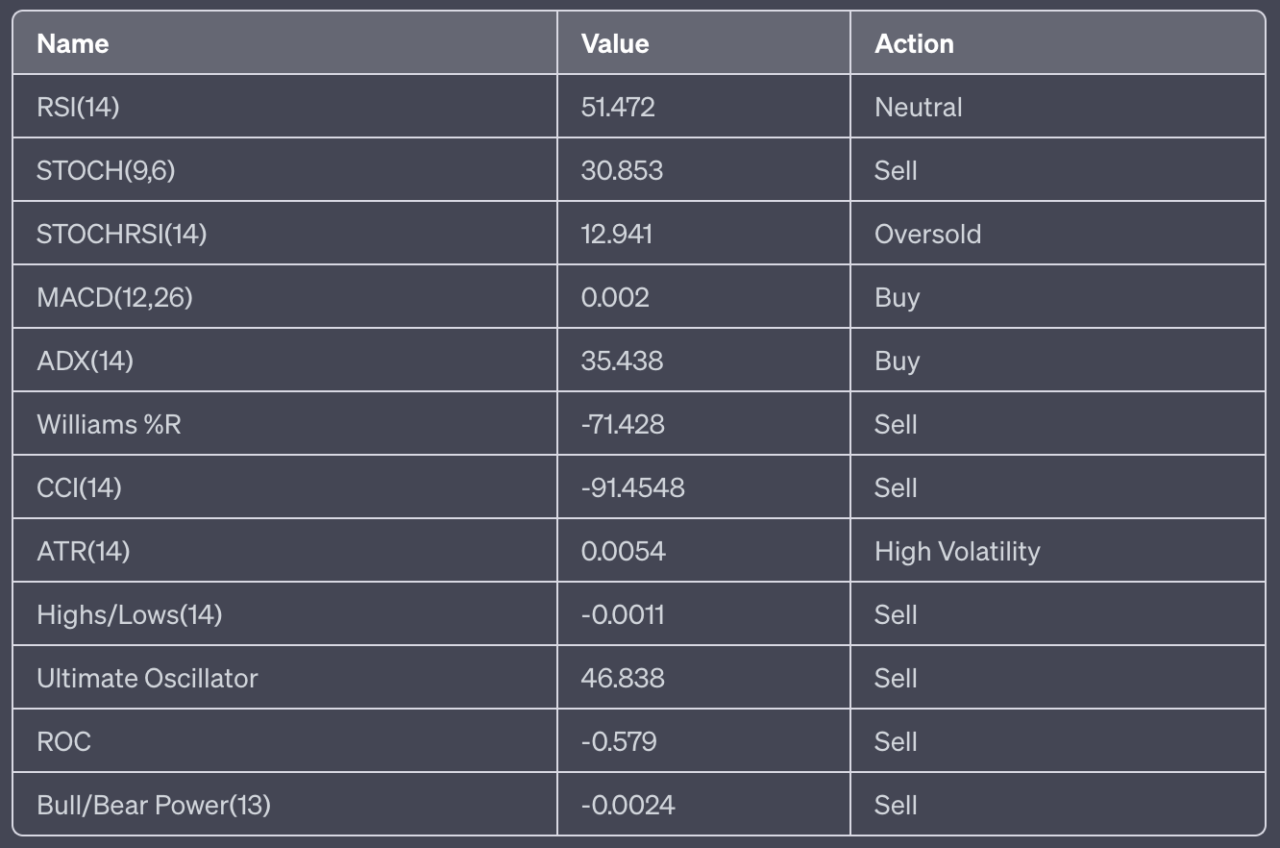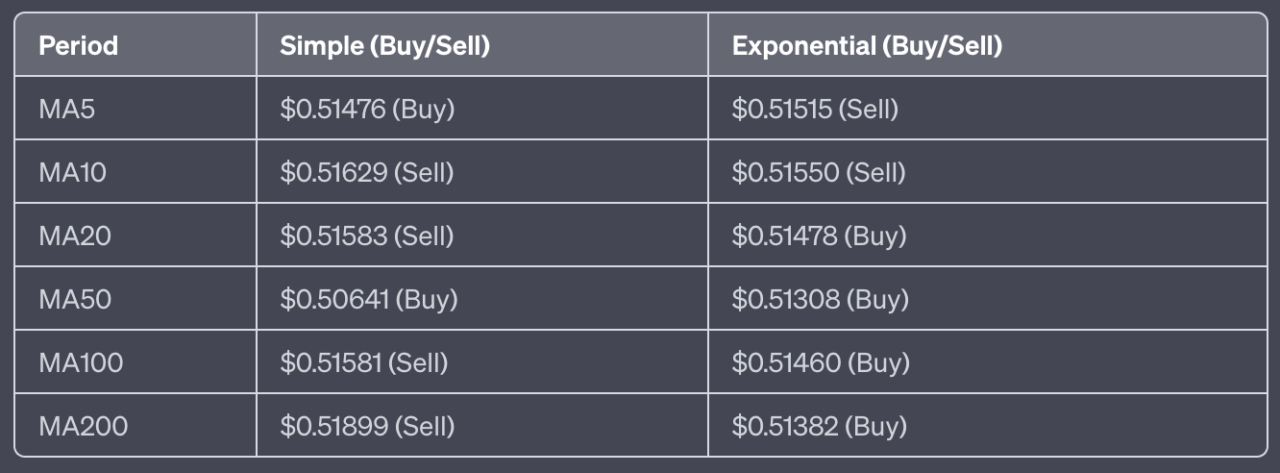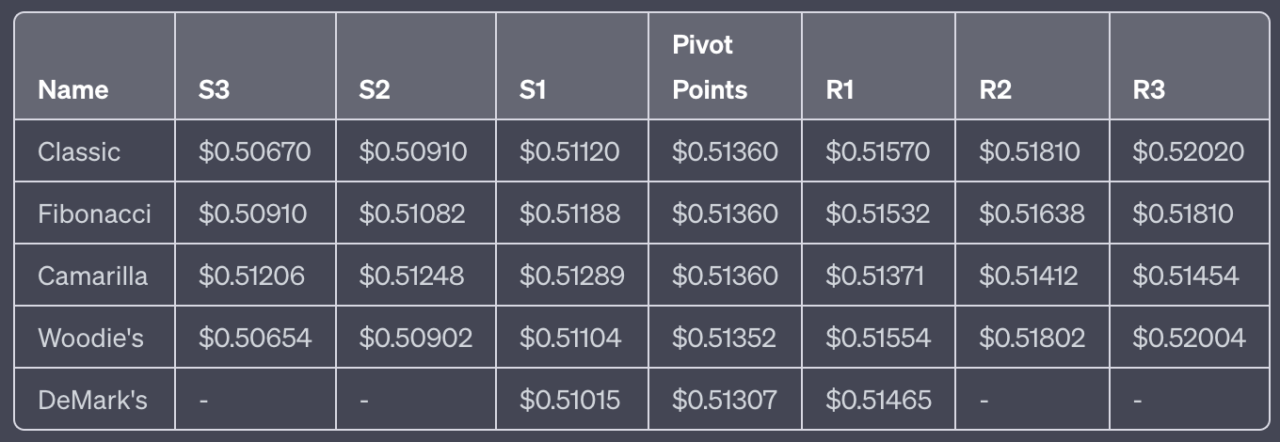Introduction
This report provides a comprehensive analysis of XRP (XRP)’s price dynamics on Binance, covering technical indicators, moving averages, pivot points, and more.
Price and Volume Snapshot
At the time of the report, XRP (XRP) was priced at $0.51780, experiencing an increase of $0.01230 (+2.43%) compared to the previous period. The snapshot was taken at 05:48:17 UTC, with a trading volume of 279,168,378 units on Binance.

Technical Indicators
Technical indicators are mathematical calculations based on an asset’s price and volume. They are used to predict future price movements and identify trading opportunities. Here is a detailed breakdown of the technical indicators for XRP (XRP):
- RSI (14): The Relative Strength Index (RSI) measures the speed and change of price movements. An RSI value of 51.472 is considered neutral, suggesting a balance between buying and selling pressures.
- STOCH (9,6): The Stochastic Oscillator compares a particular closing price of an asset to a range of its prices over a certain period of time. The value of 30.853 is considered a sell signal, suggesting bearish momentum.
- STOCHRSI (14): The Stochastic RSI is an oscillator that measures the level of the RSI relative to its high-low range over a set time period. A value of 12.941 indicates oversold conditions, suggesting a potential upward price correction.
- MACD (12,26): The Moving Average Convergence Divergence (MACD) is a trend-following momentum indicator. A positive MACD value (0.002) indicates a buy signal, suggesting a bullish trend.
- ADX (14): The Average Directional Index (ADX) measures trend strength without regard to trend direction. A value of 35.438 is considered a buy signal, suggesting a strong trend.
- Williams %R: The Williams %R is a momentum indicator that measures overbought and oversold levels. A value of -71.428 is considered a sell signal, suggesting bearish momentum.
- CCI (14): The Commodity Channel Index (CCI) is a momentum-based oscillator used to help determine when an investment vehicle is reaching a condition of being overbought or oversold. A value of -91.4548 is considered a sell signal, suggesting bearish momentum.
- ATR (14): The Average True Range (ATR) is a technical analysis indicator that measures market volatility. A value of 0.0054 suggests high volatility.
- Highs/Lows (14): This value of -0.0011 is a sell signal, suggesting bearish momentum.
- Ultimate Oscillator: The Ultimate Oscillator is a technical indicator that is used to generate buy and sell signals, incorporating the price action of an asset for three different time periods. A value of 46.838 indicates a sell signal, suggesting bearish momentum.
- ROC: The Rate of Change (ROC) is a momentum oscillator, which measures the percentage change between the current price and the n period past price. A value of -0.579 is a sell signal, suggesting bearish momentum.
- Bull/Bear Power (13): The Bull Power/Bear Power indicator measures the buying or selling pressure in the market. A value of -0.0024 is a sell signal, suggesting bearish momentum.
Here is a summary of the technical indicators in table form:

In summary, the technical indicators suggest a strong sell sentiment for XRP. There are 2 buy signals, 7 sell signals, and 1 neutral signal.
Moving Averages
Moving averages are a type of data smoothing technique that analysts use in technical analysis to identify trends in a set of data, such as stock prices. They help to reduce the noise and fluctuation in price data to present a smoother line, making it easier to see the overall direction or trend.
There are several types of moving averages, but two of the most common ones are the Simple Moving Average (SMA) and the Exponential Moving Average (EMA).
- Simple Moving Average (SMA): The SMA is calculated by adding together the prices for a certain number of periods and then dividing by that number of periods. For example, a 5-day SMA would add together the closing prices for the last 5 days and then divide by 5. The SMA gives equal weight to all the data points in its calculation.
- Exponential Moving Average (EMA): The EMA is similar to the SMA, but it gives more weight to recent data. This means it responds more quickly to recent price changes than the SMA. The calculation of the EMA is a bit more complex than the SMA, involving an exponential smoothing factor to give more weight to recent prices.
The significance of different period moving averages (like 5-day, 10-day, 20-day, 50-day, 100-day, and 200-day) lies in the timeframe that traders are interested in:
- 5-day, 10-day, and 20-day moving averages are often used for short-term trends. They respond quickly to price changes and are useful for traders looking to take advantage of short-term price movements.
- 50-day and 100-day moving averages are more medium-term. They are less sensitive to daily price fluctuations and provide a clearer picture of the medium-term trend.
- 200-day moving average is a long-term trend indicator. It’s less sensitive to daily price fluctuations and provides a clearer picture of the long-term trend. Many traders consider a market to be in a long-term uptrend when the price is above the 200-day moving average and in a long-term downtrend when it’s below.
It’s important to note that moving averages are lagging indicators, meaning they are based on past prices. They can help identify a trend but won’t predict future price movements.
Here is a detailed breakdown of the moving averages for XRP (XRP):
- MA5: The 5-day SMA is at $0.51476, suggesting a buy signal. The 5-day EMA is at $0.51515, suggesting a sell signal.
- MA10: The 10-day SMA is at $0.51629, suggesting a sell signal. The 10-day EMA is at $0.51550, suggesting a sell signal.
- MA20: The 20-day SMA is at $0.51583, suggesting a sell signal. The 20-day EMA is at $0.51478, suggesting a buy signal.
- MA50: The 50-day SMA is at $0.50641, suggesting a buy signal. The 50-day EMA is at $0.51308, suggesting a buy signal.
- MA100: The 100-day SMA is at $0.51581, suggesting a sell signal. The 100-day EMA is at $0.51460, suggesting a buy signal.
- MA200: The 200-day SMA is at $0.51899, suggesting a sell signal. The 200-day EMA is at $0.51382, suggesting a buy signal.
Here is a summary of the moving averages in table form:

In summary, the moving averages suggest a neutral sentiment for XRP since there are six buy signals and six sell signals.
Pivot Points
Pivot points are technical analysis indicators used to determine the overall trend of the market over different time frames. They are calculated using the high, low, and closing prices of a previous trading period. If the trading price for the next period is above the pivot point, it is considered a bullish sentiment, and if it is below the pivot point, it is considered bearish.
There are several methods to calculate pivot points, each with its own way of calculating support and resistance levels. Here are the methods used in this report:
- Classic: This is the most common method of calculating pivot points. The pivot point is calculated as the average of the high, low, and closing prices from the previous trading period. Support and resistance levels are then calculated off of this pivot point.
- Fibonacci: This method applies the mathematical concept of Fibonacci sequences to the price data to calculate the pivot point and associated support and resistance levels.
- Camarilla: This method uses a unique equation to calculate the pivot point and support and resistance levels, which often results in much closer levels than other methods.
- Woodie’s: This method gives more weight to the closing and opening prices when calculating the pivot point.
- DeMark’s: This method was developed by Tom DeMark and uses the relationship between the opening, closing, and high and low prices of the previous trading period to calculate the pivot point.
Here is a detailed breakdown of the pivot points for XRP (XRP):
- Classic Pivot Points: The pivot point is at $0.51360, with support levels at $0.51120 (S1), $0.50910 (S2), and $0.50670 (S3), and resistance levels at $0.51570 (R1), $0.51810 (R2), and $0.52020 (R3).
- Fibonacci Pivot Points: The pivot point is at $0.51360, with support levels at $0.51188 (S1), $0.51082 (S2), and $0.50910 (S3), and resistance levels at $0.51532 (R1), $0.51638 (R2), and $0.51810 (R3).
- Camarilla Pivot Points: The pivot point is at $0.51360, with support levels at $0.51289 (S1), $0.51248 (S2), and $0.51206 (S3), and resistance levels at $0.51371 (R1), $0.51412 (R2), and $0.51454 (R3).
- Woodie’s Pivot Points: The pivot point is at $0.51352, with support levels at $0.51104 (S1), $0.50902 (S2), and $0.50654 (S3), and resistance levels at $0.51554 (R1), $0.51802 (R2), and $0.52004 (R3).
- DeMark’s Pivot Points: The pivot point is at $0.51307, with a support level at $0.51015 (S1) and a resistance level at $0.51465 (R1).
Here is a summary of the pivot points in table form:

Featured Image Credit: Photo / illustration by “Dylan Calluy” via Unsplash









